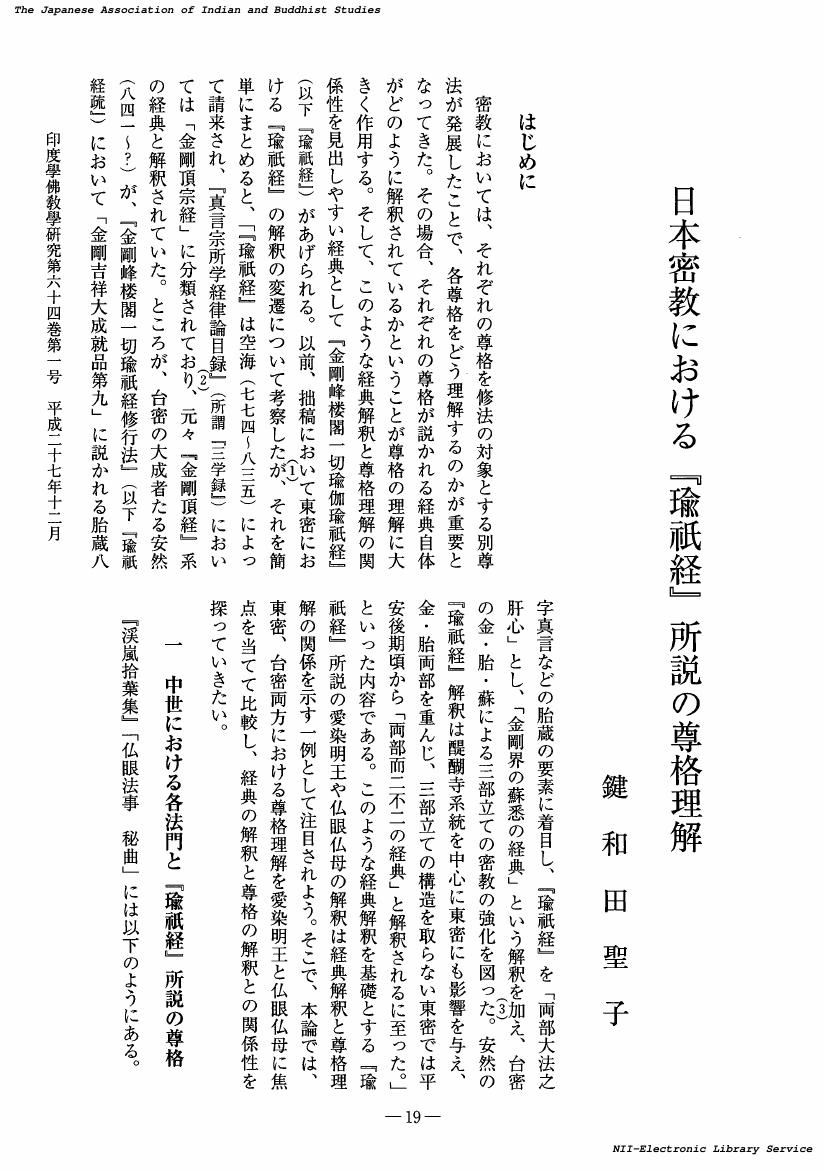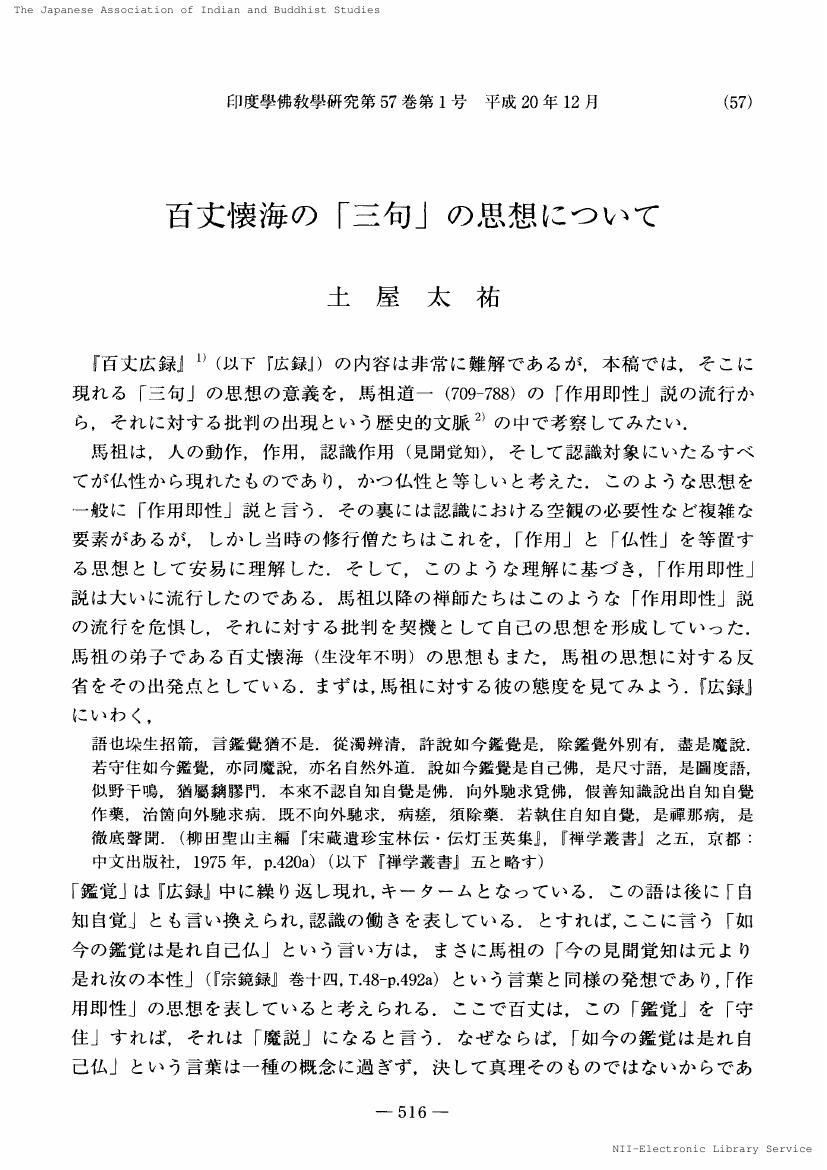1 0 0 0 OA アーラヤ識とアーラヤ智
- 著者
- 谷口 富士夫
- 出版者
- 日本印度学仏教学会
- 雑誌
- 印度學佛教學研究 (ISSN:00194344)
- 巻号頁・発行日
- vol.59, no.1, pp.450-446, 2010-12-20 (Released:2017-09-01)
1 0 0 0 新出『妙法蓮華経八香印儀軌』不空訳の発見と内容
- 著者
- 野本 覚成
- 出版者
- 日本印度学仏教学会
- 雑誌
- 印度學佛教學研究 (ISSN:00194344)
- 巻号頁・発行日
- vol.62, no.1, pp.70-75, 2013
1 0 0 0 OA 大乗戒勅許と最澄の最期をめぐる定説への疑義――『叡山大師伝』を中心に――
- 著者
- 張堂 興昭
- 出版者
- 日本印度学仏教学会
- 雑誌
- 印度學佛教學研究 (ISSN:00194344)
- 巻号頁・発行日
- vol.67, no.1, pp.28-33, 2018-12-20 (Released:2019-09-07)
- 参考文献数
- 7
The biography of Saichō, called Eizan Daishiden was written about 1200 years ago. In the biography, it is written that Saichō was repeatedly petitioning the court to allow monks of the Tendai school at Mount Hiei to become ordained as national public priests under the Bodhisattva Precepts, rather than order the traditional ordination system of the prātimokṣa. But his request was rejected, and he passed away on June 4th in 822. After his death, his supporters, usually bureaucrats, including Tomono Kunimichi, petitioned the emperor with Saichō’s earnest wish again. Finally, on June 11th, 7 days after his death, the request for the Bodhisattva Precepts was allowed.This series of stories has been handed down for 1200 years. However, some reliable reports and works of history have shown that on a day before Saichō’s passing, the emperor had already given permission for the Bodhisattva Precepts.I propose that the description about Saichō’s last moment in the Eizan Daishiden is false.
1 0 0 0 Vasubandhu 研究ンート (1)
- 著者
- 松田 和信
- 出版者
- 日本印度学仏教学会
- 雑誌
- 印度學佛教學研究 (ISSN:00194344)
- 巻号頁・発行日
- vol.32, no.2, pp.1042-1039, 1984
1 0 0 0 OA インドラへの懐疑と信 ―― RV II 12,5 ――
- 著者
- 堂山 英次郎
- 出版者
- 日本印度学仏教学会
- 雑誌
- 印度學佛教學研究 (ISSN:00194344)
- 巻号頁・発行日
- vol.64, no.2, pp.782-775, 2016-03-20 (Released:2017-09-01)
1 0 0 0 ブルーノ・ペッツオルトと富永半次郎の比較文化研究
- 著者
- 小谷 幸雄
- 出版者
- 日本印度学仏教学会
- 雑誌
- 印度學佛教學研究 (ISSN:00194344)
- 巻号頁・発行日
- vol.59, no.3, pp.1281-1284, 2011
標記の題目で,一昨年度・昨年度と廿世紀の二十〜五十年代に東京およびその周邊で従事した兩人物の比較文化研究を紹介・論述した.一方はドイツ観念論哲學を重んじる天台宗の僧侶として忠實に傅統解釋を祖述する立場で,他方は一介の粋人・求道者として自由に釋尊の五蘊正觀を奉じる立場から,共に印度・シナ・日本三國の佛教とゲーテの全生涯に及ぶ種々のテーマとの比較-但しゲーテ自身は歴史上の佛教には言及がなく,専ら兩者の精神内容の比較-を試みた.前者が「説一切有部」の無明-行と「初めにロゴスありき」のファウストの盲目意志,大乗佛教とゲーテを結ぶ萬有内在神論に着目しながら,ゲーテの相對的一元性はヘーゲル,シェリング,さらには空假中の天台の絶對一元論の前段階とする高昇至上的な形而上學を堅持する.他方,富永はゲーテの形態學的発生史の発想で梵本原典から「根本法華(甲斐蓮華展方・梵和對譯)」を取り出しながら,昭和十二年初夏より釋尊末語のvayadhamma samkharaを念稱,其のあって,戦後『正覺に就いて』でガヤー正覺の,『釋迦佛陀本紀』で最晩年のチャーパーラー正覺の心理過程を文學的に創作した.ゲーテ最晩年の一年半の不安と『ファウスト第二部』の行詰りを「ある神秘的な心理學的轉換」で打開,その経緯を『釋迦佛陀本紀余論』に記す.それこそ最高度の佛陀現象で,釋迦のayu-samkharo ossattho(永壽追求の我執が既喝した)がメフィストフェレスの「この馬鹿さは容易なもンぢゃない」に比定される下りで,この詩人ゲーテ最深の心境は,アリストテレス如き散文的徒輩なら「狂気の沙汰」と見做すだらうと,自らW.v.フムボルトに書き送った底のものである.
- 著者
- 伊藤 宏見
- 出版者
- 日本印度学仏教学会
- 雑誌
- 印度學佛教學研究 (ISSN:00194344)
- 巻号頁・発行日
- vol.19, no.2, pp.679-682, 1971
1 0 0 0 日本禅林の坐禅修行 : 定坐と摂心
- 著者
- 小川 太龍
- 出版者
- 日本印度学仏教学会
- 雑誌
- 印度學佛教學研究 (ISSN:00194344)
- 巻号頁・発行日
- vol.69, no.2, pp.608-615, 2021-03
1 0 0 0 OA <根本法華>のシンボリズム(二) : 虚空會における生中心のドラマ(一)
- 著者
- 小谷 幸雄
- 出版者
- 日本印度学仏教学会
- 雑誌
- 印度學佛教學研究 (ISSN:00194344)
- 巻号頁・発行日
- vol.55, no.3, pp.1176-1182, 2007-03-25
本學曾・2002年度(於・ソウル)で發表者は,"The Symbolism of Hokke-Proper:Morphological Studies on Saddharma Pundarika Sutra by a Private Scholar"と題して民間學者・富永半次郎の,『蓮華展方--原述作者の法華經』(梵和對譯,大野達之助・千谷七郎・風間敏夫他編1952)で完成を見た「根本法華」Hokke-Properの成立事情,その源流,即ちCh.ウパニシャッド・ラーマーヤナ・數論哲學・僧伽分裂史・阿育王碑文と,一貫したドラマとしての文脈を紹介略説した.それは西紀前一世紀頃の無名の一比丘の作と目され,現行廿八品中,序・方便・見寳塔・(勸持)・涌出・壽量・囑累の諸品(それらも全部は採用されず)を除いて他は後世の添加挿入として削除され,その發想源にゲーテ流の形態學が適用される.今回は,この發表に先立つ二ヶ月前に為した口頭發表(國際法華經學會,於マールブルク大2002年5月)の原稿に加筆,訂正したものである.霊鷲山の説法の座で無量義處三昧から釋迦は立ち,佛智の深甚無量,方便を説くと舎利弗がその所以を三請する.「佛陀とは何か」の疑問が一會から起きるや,突如一會の眞中から高さ〈五〉百由旬の塔が涌出,「正法巻舒」(←阿育王法勅)+〈白蓮華〉(←ウパニシャッド)の合成語が善哉と讚へられるシャブダ(權威ある言)として發せられる.その中を見たいとの恵光菩薩の懇願で,十方分身が還集一處する.釋迦が中空に上り,右手もて二片(對立概念)を撤去して入塔,涅槃佛(多寳如來)と半座を分つ.佛威徳を以て一會が中空に上げられると,釋迦が自分の涅槃後に「誰が正法を付囑し得るか」との問に一會の代表と他方來の菩薩が名乘をあげる.「止善男子」の一喝と共に,地皆震裂,大地から六萬ボディサットヴァ(=〈覺〉の本質,六萬←六十タントラの千倍,サーンキヤ哲學とサガラ王神話の六萬王子の換骨奪胎)が涌出,透明のアーカーシャに包まれ一會は〈五〉十中劫一少時,黙念.壽量品の〈五〉百塵鮎劫と共に〈五〉は五蘊--その軸が〈行〉蘊--の象徴.rddhyabhisamskara(サンスカーラの完成)が鍵語.因みに副題の〈生中心〉とは〈ロゴス中心〉(意識・概念偏重)の反對で,有機的全一の在り方を表すL.クラーゲスの用語.(富永師は,天台學會の招聘により奇しくも本・大正大學の講堂(昭和12年10月14日)で「私の観たる法華經」を講演された.『一』誌・特輯 第七號 法華精要富永先生の會 昭和13年2月20日)
1 0 0 0 バーチャル巡礼:――法然上人二十五霊場巡拝の一形態――
- 著者
- 山本 博子
- 出版者
- 日本印度学仏教学会
- 雑誌
- 印度學佛教學研究 (ISSN:00194344)
- 巻号頁・発行日
- vol.58, no.1, pp.154-158, 2009
1 0 0 0 OA 日本密教における『瑜祇経』所説の尊格理解
- 著者
- 鍵和田 聖子
- 出版者
- 日本印度学仏教学会
- 雑誌
- 印度學佛教學研究 (ISSN:00194344)
- 巻号頁・発行日
- vol.64, no.1, pp.19-24, 2015-12-20 (Released:2017-09-01)
1 0 0 0 OA 百丈懐海の「三句」の思想について
- 著者
- 土屋 太祐
- 出版者
- 日本印度学仏教学会
- 雑誌
- 印度學佛教學研究 (ISSN:00194344)
- 巻号頁・発行日
- vol.57, no.1, pp.516-513, 2008-12-20 (Released:2017-09-01)
1 0 0 0 『改邪鈔』と伝覚如「十三箇条制禁」-倫理観を中心として-
- 著者
- 菊藤 明道
- 出版者
- 日本印度学仏教学会
- 雑誌
- 印度學佛教學研究 (ISSN:00194344)
- 巻号頁・発行日
- vol.45, no.2, pp.597-603, 1997
1 0 0 0 京都本法寺の「楽座制度」について
- 著者
- 糸久 宝賢
- 出版者
- 日本印度学仏教学会
- 雑誌
- 印度學佛教學研究 (ISSN:00194344)
- 巻号頁・発行日
- vol.39, no.2, pp.748-752, 1991
1 0 0 0 OA 『菩薩地』における「余れるもの」
- 著者
- 本村 耐樹
- 出版者
- 日本印度学仏教学会
- 雑誌
- 印度學佛教學研究 (ISSN:00194344)
- 巻号頁・発行日
- vol.65, no.1, pp.353-348, 2016-12-20 (Released:2017-10-17)
- 参考文献数
- 6
In the Madhyāntavibhāgabhāṣya, one of the most important texts of the Yogācāra school, it is stated that two things remain as a real existence in the theory of emptiness (śūnyatā): “unreal notion” (abhūtaparikalpa) and “emptiness” (śūnyatā). The understanding of “something remaining” (avaśiṣṭa) in the Yogācāra school has been based on this theory of emptiness in this text. On the other hand, “something remaining” is also discussed in the Bodhisattvabhūmi of the Yogācārabhūmi. This text deals with the “thing itself” (vastu) and “verbal designation” (prajñapti). Many scholars understand that these two things, the “thing itself” and “verbal designation,” remain in the theory of emptiness in this text. However, through an investigation of the usage of the term “self-nature” (svabhāva) in this text, it is possible to conclude that the term “self-nature” means “the ground for the application of the verbal designation” (pravṛttinimitta). In Buddhist thought, the existence of “self-nature” was denied by the Buddha. Therefore, if “self-nature,” which is the ground for the application of the “verbal designation,” does not exist, it is also impossible that “verbal designation” exists as a real existence. Hence, the purpose of this study is to clarify that only the “thing itself” remains, but “verbal designation” does not exist in the Bodhisattvabhūmi.
1 0 0 0 OA コントゥルの『大中観他空説手引』について
- 著者
- 槇殿 伴子
- 出版者
- 日本印度学仏教学会
- 雑誌
- 印度學佛教學研究 (ISSN:00194344)
- 巻号頁・発行日
- vol.63, no.2, pp.1025-1020, 2015-03-20 (Released:2017-09-01)
1 0 0 0 OA 止観研究の歴史とその現代的意義
- 著者
- 蓑輪 顕量
- 出版者
- 日本印度学仏教学会
- 雑誌
- 印度學佛教學研究 (ISSN:00194344)
- 巻号頁・発行日
- vol.65, no.1, pp.1-10, 2016-12-20 (Released:2017-10-17)
- 参考文献数
- 11
- 被引用文献数
- 5
In the 1990s, samatha and vipassanā being introduced by Theravada monks into Japan, the interest in Buddhist meditation once again arose. One remarkable aspect of this movement is that this interest was found in ordinary society, rather than in academic circles. Later, the introduction took the form of “mindfulness,” which was less in the sense of religious practice. Much later, after the 2000s, academic fields like psychology, neuroscience, and Buddhist studies came to have an interest on this field. In recent years, they have come to question the difference between the terms chi 知 and nen 念.I myself made have researched this question through materials of the Japanese Hossō School. I focused on two monks, Jippan 実範 (?–1144) and Ryōhen 良遍 (1194–1252). In a work titled Shinrishō 真理鈔, Jippan writes that “sensitive consciousness” would be called “non-consciousness” or nirvikalpa. In the Shinjin yōketsu 真心要決 of Ryōhen, he writes that “seeing without discriminating” and “hearing without discriminating” is the state of non-consciousness. To express being in such a state, he used the words shōchi 証知 or chi, not nen. Judging from this, chi seems to have been used for expressing the state of “non-consciousness.”
1 0 0 0 OA 近代における日蓮宗僧侶の海外留学
- 著者
- 安中 尚史
- 出版者
- 日本印度学仏教学会
- 雑誌
- 印度學佛教學研究 (ISSN:00194344)
- 巻号頁・発行日
- vol.65, no.2, pp.703-710, 2017-03-20 (Released:2018-01-16)
- 参考文献数
- 5
The Nichiren sect’s first priest to study abroad was Matsuki Bunkyō 松木文恭, a pupil of Arai Nissatsu 新居日薩. Arai promoted the modernization of Nichiren Buddhism, and Matsuki studied English in Shanghai in 1886, and later went to the U.S. In those days, Arai engaged in educational reform of the Nichiren sect and organized subjects such as English and mathematics in the educational structure of Nichiren Buddhism, aiming at educational enrichment. Moreover, he had his pupils study not only at the educational facilities of the Nichiren sect but also at Keiō Gijuku 慶応義塾. Arai recognized the educational importance of the times, and we may conclude that he had Matsuki study abroad so that his pupil could acquire Western knowledge, and pursue language study. This paper considers the conduct of Matsuki and the regulations for students from the Nichiren sect studying abroad.
1 0 0 0 『立正安国論』における浄土教批判と法華最勝義について
- 著者
- 関戸 堯海
- 出版者
- 日本印度学仏教学会
- 雑誌
- 印度學佛教學研究 (ISSN:00194344)
- 巻号頁・発行日
- vol.63, no.3, pp.1118-1125, 2015
『立正安国論』の直接の執筆の理由は,正嘉元年(1257)から文応元年(1260)にかけて発生した天変地夭などの災害である.災難の興起の理由について日蓮は諸経典を紐解き検討した.災難の興起について論じた,これに先立つ著作として『災難興起由来』『災難対治鈔』『守護国家論』などがある.『立正安国論』は,文応元年(1260)七月十六日に,前執権北条時頼に奏進された諌暁の書である.時頼は仏教を篤く信仰していた.これが,日蓮が『立正安国論』を彼に奏進した理由の一つである.『立正安国論』では,法然の『選択本願念仏集』などの経論疏を抄録して,浄土教批判を展開し,他国侵逼難と自界叛逆難を予言して,『法華経』に帰依すべきことを勧めている.けれども,『法華経』の教義や理念については詳しく論じられていない.これは,日蓮が公場対決を期していたことに由来すると考えられている.なお,法然批判の先駆者として,園城寺の公胤,定照,華厳宗の高弁などがある.『立正安国論』は旅客(北条時頼)と僧房の主人(日蓮)との,「九問九答」と「客の領解」(十番問答)によって構成されている.それを序分・正宗分・流通分の三段に分けて考えてみると,第一問答から第八問答までが序分,第九問答が正宗分,第十段の客の領解が流通分となる.序分では「災難の由来と経証」「謗法の人と法」「災難対治」「謗法の禁断」などについて説かれ,念仏を禁断することによって国難を防ぐことを明らかにする「破邪」の段であるとされる.そして,第九問答が正宗分であり,他国侵逼難と自界叛逆難を予言し『法華経』に帰依すべきことを勧める「顕正」の段である.流通分は第十段の「客の領解」のみとなっている.考察の結果として,日蓮の法華最勝義については要略して述べるにとどまっていることがわかった.批判の主眼を法然『選択集』に絞り,北条時頼から召喚があった時には,日蓮の宗教観に関する詳細な面談を遂げようという『立正安国論』の趣旨が再確認できたと思われる.
1 0 0 0 アヴィータ論の展開:因の三相の観点から
- 著者
- 岡崎 康浩
- 出版者
- 日本印度学仏教学会
- 雑誌
- 印度學佛教學研究 (ISSN:00194344)
- 巻号頁・発行日
- vol.54, no.3, pp.1133-1138, 2006
本論は, アヴィータ論のシャスティタントラからウッドヨータカラにいたる展開を因の三相の観点から論じ, ウッドヨータカラのこの論に対する貢献を明らかにしようとしたものである. シャスティタントラのアヴィータ論は, 夙にフラウワルナーによって再構成されたが, 彼の再構成は, その論証式, 論証形式という点でいくつか不足している点がある. その不足部分を補って再考した場合, アヴィータの論証は五肢作法の理由・例示・適用・結論に残余法を加えたような論証形態になっており, これを後の三相説から見ると残余法の部分が余計であるように思われる. ディグナーガは残余法を除き三肢作法の理由が帰謬形式になっているものをアヴィータとして提示したが, 因の第1相と抵触するとした. これに対し, ウッドヨータカラは否定的属性も主題の属性になりうることを主張し帰謬的性格を保持したまま因の三相説の枠組みに組み入れたのである.





